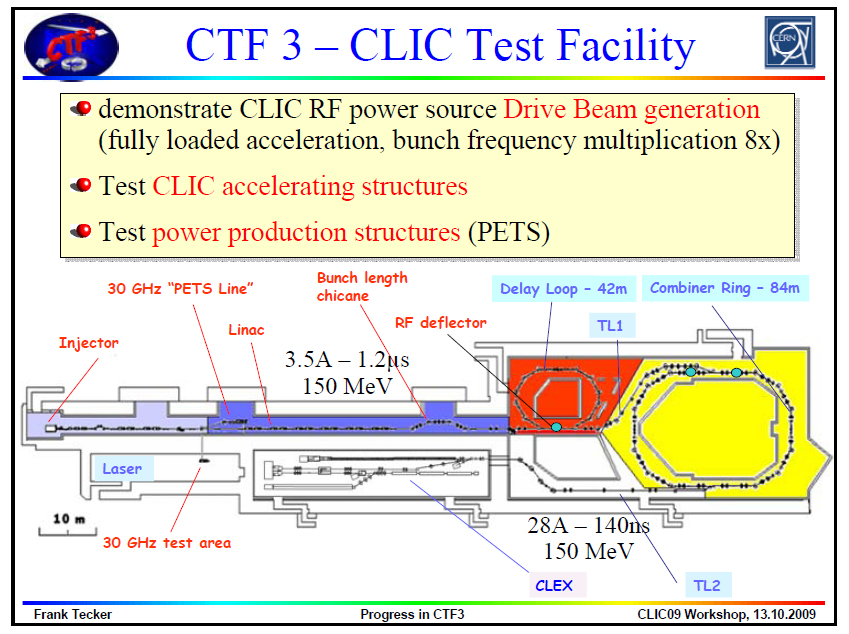Director's Corner
5 November 2009
 Barry Barish |
Report on the CLIC workshop
The September ALCPG and ILC meeting in Albuquerque, US, featured a plenary talk on the Compact Linear Collider Study CLIC by Jean–Pierre Delahaye, who gave a very nice description of the CLIC status and plans. His talk was well received by the ILC audience and it represented another step in our efforts to increase communication and cooperation between the two groups. In return, I gave a plenary talk on the ILC status and plans at the CLIC09 Workshop at CERN on 12 October. Like Delahaye in Albuquerque, I was also warmly received at the CLIC workshop and was pleased to have the opportunity to reciprocate to the CLIC audience. This group of dedicated scientists is working towards the same ultimate goal, a future lepton collider for our field to complement the LHC. An extra benefit for me personally was that participating in the workshop gave me effectively an intense crash course on CLIC. Today, I share a few personal observations from the workshop.
 The Compact Linear Collider based on a two–beam concept The Compact Linear Collider based on a two–beam concept |
 Schematic of the CTF 3 test facility to demonstrate the CLIC drive beam concept (from Frank Tecker’s CLIC09 Workshop talk) Schematic of the CTF 3 test facility to demonstrate the CLIC drive beam concept (from Frank Tecker’s CLIC09 Workshop talk) |
Two topics stood out most for me at this workshop: the detailed planning to produce a Conceptual Design Report (CDR) by the end of 2010; and the ambitious experiments that are underway in the CLIC test facility CTF 3 to demonstrate feasibility of the two–beam scheme that underpins the CLIC concept. In addition, Hitoshi Yamamoto already wrote in ILC NewsLine about the CLIC physics detector effort that is getting underway and its many synergies with the ILC detector studies.
We were told that the Conceptual Design Report will be roughly equivalent in technical detail to the ILC Reference Design Report (RDR) produced in 2007. It will consist of three volumes: Executive Summary, Accelerator, and Physics and Detectors. However, in contrast to the ILC RDR, the emphasis of this report will be to document the two–beam feasibility test results. In addition, the report will present a conceptual design based on this concept, much as our RDR does for SCRF technology. It is useful to note that, despite the very different underlying technology, there are many important points of comparison, including cost, performance and risk. We are having important discussions with the CLIC groups through our joint working groups (see my corner from 18 June) that gives both insight into what they will present and input as to how to approach the points of comparison.
The CLIC CDR is a very important milestone as it will provide the basis for a major decision by the CERN Council in early 2011. They will be asked to decide whether to undertake a multi–year technical design for CLIC scheduled to be completed by the end of 2016. In addition to working towards a technical design, there will be continuing R&D on performance and cost issues, as well as a programme of engineering optimisation and industrialisation. The CLIC leadership believes that upon completion of the Technical Design Phase, a decision could be possible to build CLIC on a time scale of the mid–2020s.
 Comparison of CTF 3 test facility parameters and CLIC parameters Comparison of CTF 3 test facility parameters and CLIC parameters |
 Group photo taken during the CLIC workshop. Image: CERN. Group photo taken during the CLIC workshop. Image: CERN. |
It is worth commenting that for ILC we have taken a somewhat different approach towards readiness: we are putting large emphasis on performing ILC–like system and beam tests. The first tests are at the FLASH facility at DESY and we are already learning a tremendous amount from those very encouraging tests. For the longer term, we are making large investments in building up test facilities at both Fermilab and KEK where future system and beam tests using ILC cryomodules will be performed.
Successful CTF 3 tests will clearly be a crucial element in determining whether a lepton collider design is feasible and can be based on CLIC technology. The tests being undertaken involve a broad and detailed R&D programme including tests of two–beam acceleration, RF structures, ultra–low beam emittance and beam sizes, detector background issues and operational and machine protection issues.
I have written several times about the CLIC/ILC collaboration and I expect these working groups will play an important role in insuring that information inviting ILC and CLIC comparisons will be presented in useful and reliable ways. We plan to work closely with CLIC through these joint working groups to find the best approaches towards such comparisons.
Overall, I cannot but help be impressed by the enthusiastic and dedicated efforts being made towards CLIC. Those of us working on the ILC share the same belief that our community will rally around a lepton collider for the next major project in our field, once LHC results point the way in terms of energy for this collider. Pursuing different approaches towards a future linear collider is healthy and, in my opinion, will help make the choices that will match the capabilities of the next machine to the science opportunities.
-- Barry Barish